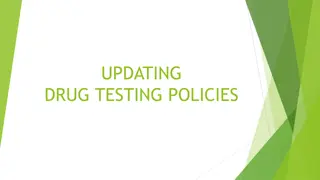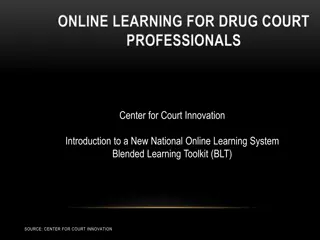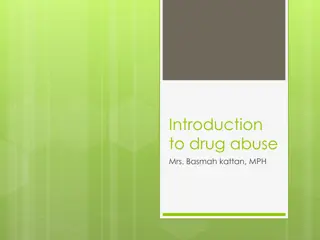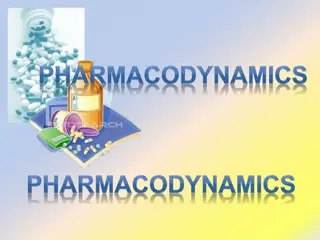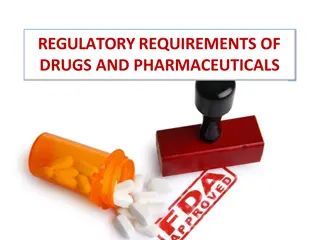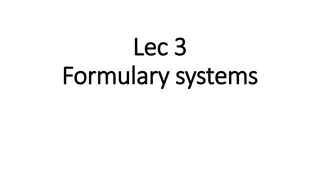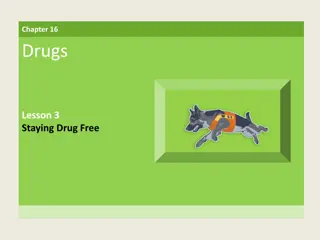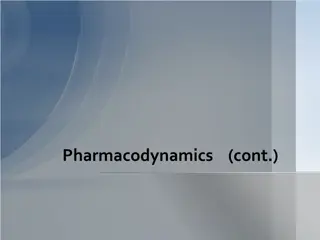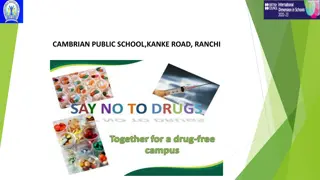Understanding Drug Categories and Schedules
Explore the different categories of drugs such as depressants, stimulants, hallucinogens, and inhalants, along with the classification under drug schedules ranging from Schedule I to Schedule V. Learn about the impacts of these drugs on the mind and body, including examples for each category and schedule.
Download Presentation

Please find below an Image/Link to download the presentation.
The content on the website is provided AS IS for your information and personal use only. It may not be sold, licensed, or shared on other websites without obtaining consent from the author. Download presentation by click this link. If you encounter any issues during the download, it is possible that the publisher has removed the file from their server.
E N D
Presentation Transcript
JOKE OF THE DAY Q: Can a kangaroo jump higher than the Empire State Building? A: Of course. The Empire State Building can't jump.
DRUG CATEGORIES Name: ______________________ Period: ______________________
DRUG CATEGORIES Many different way to categorize drugs Impact on Body & Mind Users feel active or relaxed Chemical similarities To understand impact and risks We are going to categorize them by the impact they have on the mind and body Depressants Stimulants Hallucinogens Inhalants
DRUG SCHEDULE Schedule 1: No currently accepted medical use and a high potential for abuse. Examples: heroin, (LSD), marijuana, ecstasy Schedule 2: defined as drugs with a high potential for abuse, with use potentially leading to severe psychological or physical dependence. These drugs are also considered dangerous. Examples: (Vicodin), cocaine, methamphetamine, (Demerol), oxycodone (OxyContin), fentanyl, Dexedrine, Adderall, and Ritalin
DRUG SCHEDULE Schedule III: defined as drugs with a moderate to low potential for physical and psychological dependence. Schedule III drugs abuse potential is less than Schedule I and Schedule II drugs but more than Schedule IV. Examples: Tylenol with codeine, ketamine, anabolic steroids, testosterone Schedule IV: are defined as drugs with a low potential for abuse and low risk of dependence. Examples: Xanax, Soma, Darvon, Darvocet, Valium, Ativan, Talwin, Ambien, Tramadol
DRUG SCHEDULE Schedule V: defined as drugs with lower potential for abuse than Schedule IV and consist of preparations containing limited quantities of certain narcotics. Schedule V drugs are generally used for antidiarrheal, antitussive, and analgesic purposes. Examples: cough preparations with less than 200 milligrams of codeine or per 100 milliliters (Robitussin AC), Lomotil, Motofen, Lyrica, Parepectolin
DEPRESSANTS Depressants slow down activity in the central nervous system of your body. These drugs are also called downers because they slow the body down and seem to give feelings of relaxation. Doctors commonly prescribe depressants to help people who have anger management issues, stressed or tensed. Examples: alcohol, barbiturates, Rx depressant pills, marijuana , opioids
STIMULANTS These drugs speed up the body s nervous system and create a feeling of energy. They are also called uppers because of their ability to make you feel very awake. Examples are amphetamines (Meth, caffeine, nicotine, cocaine, marijuana)
HALLUCINOGENS Affects all senses; makes a user feel, hear, see things that don t exist in the time being. Drugs which distort reality and facts Switching emotions is frequent. Examples: LSD (acid), PCP, mushrooms
INHALANTS Found in ordinary household chemical products and anesthetics. Readily available and accessible to young children Inhalant toxins are similar to those of alcohol, the only difference is the foul smell. Abuse can lead to delusions, brain damage, liver damage, comatose and death. Examples are acetone, rugby (solvent), spray paints, cleaning fluids and air conditioner fluids (Freon).
MARIJUANA Marijuana has depressant, hallucinogenic, and stimulant properties. Does not neatly fit into one single category. Depressant Effects Slows down messages to the brain, relaxes muscles and lowers inhibitions Hallucinogenic Effects Large does can case hallucinations, delusions and loss of sense of personal identity. Stimulants Cause rapid heartbeat, elevated mood and paranoia .
WHY IS IT IMPORTANT TO KNOW A DRUG S CATEGORY/CATEGORIES? To be able to identify the signs of a drug user To be able to help a victim of overdose To understand the major effects of many different drugs To understand how drugs interact with each other
ESSENTIAL QUESTION Define stimulants These drugs speed up the body s nervous system and create a feeling of energy.




